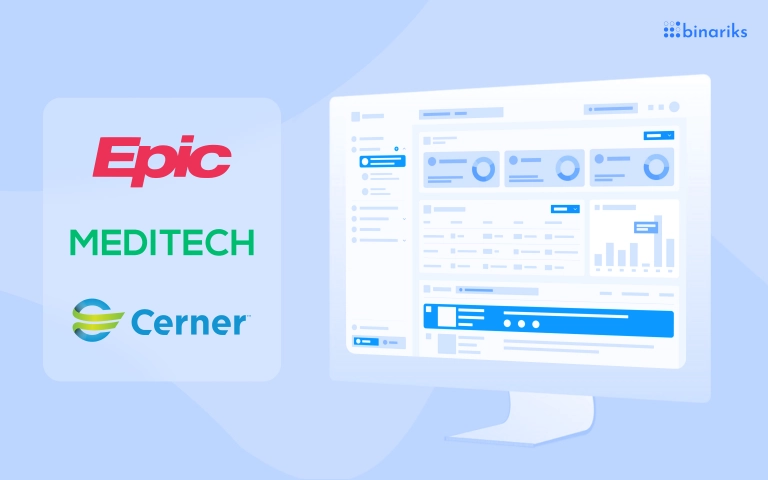EHR adoption rates have climbed up to 96% . From small to big, healthcare providers are adopting EHR systems like Cerner, Epic, and MEDITECH for patient management. They get an electronic medical record system and layer other applications on top of it. It allows them to build a single, multi-component solution that connects healthcare data and provides controlled access.
Despite the clear benefits, EHR integration also brings interoperability challenges. It requires experience in API integration and expertise in implementing interoperability standards that most companies don’t have. Therefore, healthcare organizations often ask tech partners to help them connect multiple disparate third-party solutions to an EHR or EMR platform.
Keep reading and learn about the key EHR and EMR integration rules, and how to connect a system like Epic, Cerner EHR, or MEDITECH with third-party software.

Epic EHR system
Epic Systems Corporation is an electronic health record (EHR) based in Verona, Wisconsin, which was founded in 1979. As of 2021, the market share of Epic is 31% (source ).
With its large market share, Epic EHR serves all kinds of clients across the healthcare system, but the company's primary focus is large healthcare organizations and hospital systems. Some of the company's well-known clients include Cleveland Clinic, Johns Hopkins, and Mayo Clinic.
Key features
- MyChart: A patient portal where a patient can schedule appointments, access medical records, and ask for medication refills.
- EpicCare: This is the main portal of Epic, which involves specific versions for ambulatory and inpatient settings.
- Epic's Care Everywhere and Share Everywhere: Platforms for sharing medical records between organizations and between patients and clinicians.
- Healthy Planet: A software module that allows clinicians to analyze patient populations and identify care gaps.
Strengths
The strongest user interface on the market
The user interface of the Epic EHR system is often praised as one of the strongest on the market. It has an intuitive design, which offers a great influence on the efficiency of workflow. What is more, Epic allows its customers a high level of personalization. Each department and even an individual professional can customize services based on their specific workflow.
Another plus is that the user can access a variety of features from the same interface. That being said, the system is still extremely complex and requires extensive training.
Focus on interoperability
Epic has dedicated platforms, Care Everywhere and Share Everywhere, which allow data sharing between multiple organizations, especially the ones that use the Epic EHR system as well. These features allow accessing up-to-date patient history. Patients can also grant physicians temporary access to their electronic track records.
Improved patient engagement
Epic has a dedicated MyChart patient portal, which provides functionality for patients to actively engage in their treatment. It includes easy and intuitive functionality that allows them to access their own track record, schedule appointments, and refill prescriptions online. MyChart also serves as an excellent tool for communicating with healthcare providers.
Weaknesses
High cost and system complexity
Epic is the most expensive EHR system on the market, up to the point that many healthcare organizations simply cannot afford it. This remains one of the strongest Epic disadvantages. The extremely high cost is a sum of the costs of software, hardware, implementation, training, and ongoing maintenance.
Implementation of Epic usually requires not just an implementation specialist, but an entire team of IT specialists, as it is impossible to navigate system complexity without a team. That is the price healthcare organizations have to pay for the comprehensive features and extensive customization options offered by Epic.
Lack of extensive integration with non-Epic systems
Despite excellent interoperability with Epic instruments, there is a lack of sufficient integration with non-Epic systems, especially the ones that use different exchange standards. This issue is a result of the limitations of proprietary software architecture and limited data mapping.
However, these limitations can also be due to Epic not wishing to share the data with its competitors.
Best practices for Epic EHR integration
- Ensure you have a data mapping and migration strategy for a smooth transition to the Epic EHR system.
- Use the Epic interoperability capabilities that make the most sense for your organization.
- Consider which customization options work best for your organization.
- Create a training strategy and leave plenty of time for staff training.
- Have a dedicated IT team navigating all integration processes.
Cerner EHR system
Founded in 1979, Cerner Corporation is a supplier of health information technology services based in Kansas City, Missouri.
The market share of Cerner is second only to Epic and is at 25% as of 2020. The company has more than 27,500 associates worldwide, serving in 35 countries.
Cerner serves hospitals and healthcare systems of all sizes. Some of the company's notable clients include the U.S. Department of Defense and the U.S. Department of Veterans Affairs.
Key features
- Cerner PowerChart Ambulatory: This tool is aimed at physicians of all types and sizes of practice. It supports E-prescribing, chart search, patient portal, and other functions.
- HealtheIntent: This is a platform for population health management focused on data aggregation and care coordination for different populations.
- Cerner Millennium: Cerner's key product is a platform for large hospitals. It offers documentation, data analysis, reporting, and drug alerts.
- CareTracker by Cerner: This is a dedicated platform for care centers and assisted living facilities.
- HealtheLife: This is the name for Cerner's patient platform, offering patients access to their health information.
Strengths
Scalability
When it comes to scalability, Cerner EMR is a top dog on the market, as demonstrated by how seamlessly it works for large and small healthcare organizations alike. Cerner has a modular architecture, meaning that organizations can implement different modules at a time.
Speaking of Epic vs. Cerner, this also makes Cerner less complex, as not every feature of the system has to be implemented at once.
Extensive experience
Cerner has been on the market for over 40 years. Thanks to its scalability, it has experience with all types of healthcare settings, from the smallest to the largest ones. Cerner's adaptability to different healthcare structures in various sectors of healthcare offers it a unique place in the Epic vs. Cerner vs. Meditech debate.
Interoperability with other systems
Unlike Epic, Cerner expands its interoperability properties not just to its systems but to competitors as well. Cerner has an open integration API policy, facilitating data exchange with third-party applications.
It also supports an extensive list of interoperability standards, including HL7, FHIR, and CDA. CareAware device connectivity platform also supports a more open exchange of information.
Weaknesses
Non-intuitive user interface
Some nursing professionals involved with Cerner report that the system interface is not intuitive compared to Epic. While both Epic and Cerner have complex interfaces, the former is much easier to navigate. Some potential concerns with Cerner UI include difficulties finding several functions and working with several windows at once.
Complex implementation and customization limitations
Though cheaper and easier to implement than Epic, Cerner's software is still very complex and requires comprehensive staff training at all levels. The options for customizing software and workflow of particular departments and individual personnel are not extensive.
Best Practices for Cerner EHR integration
- Consider which customization options and modules will make sense for your organization.
- Leave room for extensive personnel training.
- Make use of interoperability with Cerner native systems and other systems.
- Consider data cleansing, migration, and validation in the process of migration.
MEDITECH EHR software
MEDITECH, or Medical Information Technology, Inc., is a Massachusetts-based software and service company that offers EHR systems to healthcare organizations worldwide. The company is one of the earliest in this business, founded in 1969. MEDITECH is the third-largest provider of EHR services on the market, with a market share of 16% (source ).
MEDITECH manages to occupy a unique niche in the market, as it primarily targets smaller hospitals and community healthcare organizations. This is because it is more cost-effective compared to Cerner and EPIC and easier to implement without an extensive IT team.
Key features
- MEDITECH Expanse: Web-based EHR portal for clinicians, offering billing, e-prescriptions, scheduling, and access to patient information.
- MEDITECH Surveillance: A tool analyzing patient healthcare information in real time.
- MEDITECH Patient Portal: A tool for patients to manage their information and appointments.
Strengths
Cost-effectiveness
Out of Epic, Cerner, and Meditech, the latter is by far the most affordable option. Meditech does not have the expansive features of the other two platforms, which consequently makes its price lower. The pricing model itself is very simple, without additional hidden costs.
Ease of implementation
Since MEDITECH caters to smaller hospitals and healthcare organizations, there are fewer complex functions to manage throughout the implementation process. MEDITECH offers a simple, standardized implementation process with standard training modules, which does not differ much from organization to organization.
Support for population health management
MEDITECH has a well-developed tool for population health management. It allows for tracking health outcomes of individual patients and coordinating care. The tools are a part of different MEDitech instruments, including its Patient and Consumer Health Portal. Reporting and analytics of healthcare outcomes are on point.
Weaknesses
Lack of functionality for third-party integration
Between Epic, Cerner, and Meditech, Meditech integration is the weakest because it uses a proprietary system. Meditech uses only the HL7 protocol, while Cerner or Epic uses others, including FHIR.
Weak user interface
MEDITECH interface is not as well-developed and less intuitive compared to both Epic and Cerner. This is the result of limited features and budget constraints. However, MEDITECH keeps developing with features like Expanse and is on the road to solving this issue.
Best Practices for MEDITECH EHR integration
- Use MEDITECH standardized implementation process and resources.
- Involve all stakeholders during the early stage of implementation to make sure that system meets everyone's needs.
- Outline the specific goals of your organization before implementation.
What to choose between Epic, Cerner, and MEDITECH?
Cerner, Epic, and MEDITECH each have their unique place in the EHR market. Cerner is a more popular option in clinical and ambulatory care, a space where Epic aims to grow with its novel solutions.
Both offer functionalities like revenue cycle management, interoperability, mobile access, artificial intelligence, and telemedicine software development to reduce expenses.
MEDITECH also offers these solutions, with a particular focus on cost-effectiveness and ease of implementation, making this system popular among smaller hospitals and community health systems.
However, their opportunities differ in several areas:
- Cerner does not have a CRM, although Epic does. MEDITECH, on the other hand, while not offering a full-fledged CRM, does provide patient portal functionalities for enhanced patient communication and engagement.
- Cerner and MEDITECH offer consulting services, but Epic does not. That is often the vital aspect for smaller healthcare organizations that choose MEDITECH, as they might not have as extensive IT resources.
- Epic integration does not give consumers real-time data, but both Cerner and MEDITECH do. MEDITECH's data repository provides real-time clinical and financial data for reporting and decision-making purposes.
Here is the table that compares the basic functions of Epic vs. Meditech vs. Cerner:

To sum up, Epic's solutions are perfect for hospitals searching for simple, secure, and effective ways to manage electronic medical data. Cerner stands out in the areas of clinical and ambulatory care, providing real-time data and consulting services. MEDITECH, while providing similar functionalities, stands out with its cost-effective solutions and easy implementation process, making it a good choice for smaller healthcare organizations.
Cerner to Epic (or MEDITECH) Conversion
There is no way to migrate from Cerner to Epic or MEDITECH without leaving the hospital system. A conversion is a radical step to take, which is mostly associated with mergers and acquisitions.
To implement a Cerner to Epic migration or any other migration, you will need a complex legacy migration strategy that will take at least one year to implement. Migrating all clinical data is rarely feasible, so most hospitals will opt for extracting two years' worth of clinical data at most, with other data placed into a legacy system.
Some of the factors that should be taken into consideration include:
- Epic, Cerner, and Meditech all have unique data formats. Epic vs. Meditech migration will involve putting data into a different format.
- Epic, Cerner, and Meditech all have different workflow processes, so Cerner to Epic conversion is also about adjusting the workflow.
- Compared to Epic and Meditech, the customization options of Cerner are limited.
- Cerner offers superior interoperability with third parties compared to Epic and Meditech, so issues may arise.
Overall, Cerner to Epic migration is a radical step that should not be taken lightly. But, with the procedure ready, it is more than possible to make the most of this transition.
Binariks experience in EHR integration
Binariks is a healthcare software development company that offers EHR data transfer and engineering services. Our engineers can handle any technology requirement, from creating remote patient monitoring software to telemedicine solutions.
We created a web and mobile app for an electronic visit verification platform that improves hospital management. Our devoted developers use various technologies, including React Native, Java, and Swift, and have shown exceptional proactivity in providing a high-quality healthcare product .
What’s more, our experts redesigned the healthcare platform to solution architecture and followed FHIR. The supplier of non-emergency medical transportation aimed to facilitate interoperability and ease connections with third-party administrators and clinics.
Then again, visit our portfolio for additional information about healthcare success cases.
Final thoughts
Interoperability in healthcare enables providers to share the same records, making treatment decisions more data-driven. Integrated EHRs and third-party software optimize insurance reimbursement , speed up access to patient records, connect referring doctors and specialists, and yield numerous other benefits.
Epic is the easiest integration with FHIR API ensuring data interoperability compliance and smooth communication between the connected software.
If you seek professional tech assistance, Binariks offers best practices for EHR integration services. We connect third-party software to Cerner, MEDITECH, Epic, or any EHR system of your choice.
Let’s get in touch to discuss your tech needs for projects.
FAQ
Share

